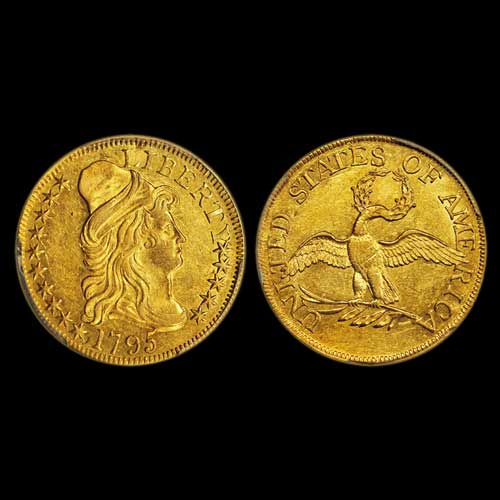Alexander Collection amuses with 1795 Capped Bust, Small Eagle Gold Half Eagle
2017-11-02 Thu
From 9th to 12th November, at the Baltimore Convention Center, Stack’s Bowers Galleries official auctions of the Whitman Coin and Collectibles Expo will take place, where they will showcase coins from the Alexander Collection.One of the highlights, a handsome 1795 Capped Bust, Small Eagle gold $5 half eagle from the collection graded About Uncirculated 58 by Professional Coin Grading Service, has been off the market since 1947 when the collector purchased it from a dealer in Miami.
It was at the end of the 19th century when a young man along with his immigrant parents came to the United States. He formed the Alexander Collection. He joined the Navy and started a family business that survived the Great Depression, and he began collecting coins in the 1920s.
He was a Stack’s regular, also buying from legendary dealers including Abe Kosoff, B. Max Mehl, Frank Katen, among others. The collection remained intact, though the unnamed collector passed away more than half a century ago. Stack’s Bowers remarked of the upcoming auction, “This has opened new gates for the new generation of collectors, who have the opportunity to enjoy these distinctively American artifacts collected by a passionately patriotic American.”
On the 1795 Capped Bust gold half eagle — the first gold coin struck for the United States at the Philadelphia Mint — the description reports, “Satin to semi-reflective surfaces retain much of the original finish, overall full detail also confirming a brief stint in active commerce for this well-preserved example.” The eagle’s eye is clearly defined and a few light planchet adjustment marks on the reverse are seen. Planchet adjustment marks like these took place at the Mint to bring a planchet to its correct weight and are not considered damage.
The issue’s mintage of 8,707 is spread out among 12 known die marriages, of which the offered Bass-Dannreuther 3 example represents the most common die marriage with an estimated mintage of 2,000 to 3,000 coins. Stack’s Bowers places this mintage in a framework.
John W. Dannreuther estimated that 175 to 225 examples survive of this variety, in his 2006 book Early U.S. Gold Coin Varieties: A Study of Die States, 1795-1834, and wrote that it is the most readily obtainable die marriage of the date.
Latest News
-
Janma Kalnayak of Bhagwan Mahavir
2024-04-24 WedOn 21st April 2024 which was the 2550th Janma Kalnyanak of Bhagwan Mahavir Swami, PM Modi unveile...
-
Gold Pagoda of Vijaynagar Empire King Deva Raya I
2024-04-10 WedKing Deva Raya I of the Vijayanagara Empire was a patron of Kannada literature and architecture. He ...
-
Silver Denarius of Septimus Severus
2024-04-05 FriLucius Septimius Severus served as the Roman emperor from 193 to 211 AD. Severus sat on the throne o...
-
Extremely rare 'Malaharamari' type Gold Gadyana of King Guhalladeva-III Sold for INR 611000
2024-04-03 WedTribhuvanamalla, also known as Guhalladeva III, was the ruler of the Kadamba dynasty. His reign coin...
-
90 Years of RBI
2024-04-02 TueOn 1st April, PM #Modi unveiled a special commemorative coin marking 90 Years since the foundation o...

